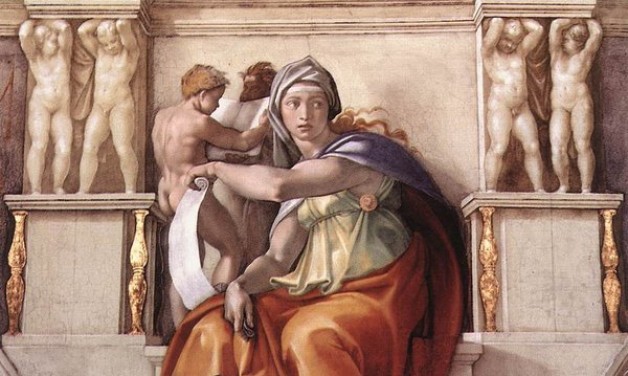If you were at a Dominican church on the feast of Christmas or Epiphany, you might have heard the Sequence Laetabundus, wherein the Church sings that the mother of Christ poured him forth like a star pours forth its splendor (sicut sidus radium . . . pari forma). You may also have been surprised to hear it sung that this birth was foretold—strange as it seems—by “Sibylline verses.”
The Laetabundus is not the only Sequence that credits pagan prophecy for predicting events in Salvation History. The Dies Irae famously opens with an apocalyptic vision of the universe reduced to embers and the just one ready to judge—to this vision, so the Sequence goes, both David and the Sibyl bore witness (teste David cum Sibylla).
Sibyl comes from the Greek term Sibylla meaning prophetess. The sibyls were women of Greco-Roman antiquity who reputedly prophesied at holy sites under the influence of a deity. Candidates for the prophetess of the Laetabundus are many, but perhaps three deserve special mention: the Cumaean Sibyl (on the Mediterranean coast, twenty miles west of Naples), the sibyl at Erythrae (on the west coast of Asia Minor), and the sibyl of Tibur (today’s Tivoli, just northeast of Rome). As for the sibyl of the Dies Irae, the Tiburtine seems as good a competitor as any.
Sibyls also show up elsewhere in the Christian tradition. Both Tertullian and St. Clement speak very favorably of a sibyl, and St. Augustine quotes at great length the Erythraean Sibyl, who, he says, “certainly wrote some things concerning Christ which are quite manifest.” On the ceiling of the Sistine Chapel, Michelangelo painted five sibyls seated among seven prophets of the Old Testament, as if Sibylline prophecy were a parallel preparation for the coming of Christ.
Certainly, for the Church, the sibyls signify that even fallen human nature is capable of right thinking about God and of a pious expectation of divine help. They also highlight the universality of Christ’s mission. But much the same could be said of Greek culture in general. Shouldn’t the sibyls have something more specific to add?
Unfortunately, it’s difficult to take the prophecies at face value since most of our sibylline lore is traced back to the Sibylline Oracles, a Judeo-Christian production compiled over seven centuries (from the 2nd century BC to the 5th century AD) whose historicity is open to question. It can be said, however, that Virgil may well have drawn on an early edition of this work or its sources in his fourth eclogue (published around 39–38 BC), in which he cites the Cumaean Sibyl as having foretold that an offspring of the gods will be born of a virgin and will free the world from its wickedness and fear. In Jesus of Nazareth: the Infancy Narratives, Pope Benedict comments on the Christian import of this text and avers that “the figures of the virgin and the divine child belong in some sense to the archetypal images of human hope, which emerge at times of crisis and expectation, even without there being any concrete figures in view.”
Another approach to the sibyl appears in the Pope’s discussion of the Magi. The star alone, he says, is insufficient to have provoked their pilgrimage: “Before the star could convey a message, there had to be a promise in circulation, something akin to Balaam’s oracle.” Balaam, it should be recalled, was no friend of the Jews and yet he prophesied in their favor: “I see him, but not now; I behold him, but not nigh: a star shall come forth out of Jacob and a scepter shall rise out of Israel” (Nm 24:17). Balaam is depicted as a contemporary of Moses, so, in order for his oracle to have reached the Magi, it must have circulated for some centuries, likely among schools of paganism—that is, in the kind of society one might find a sibyl. If God could speak through Balaam and give the star significance for the sake of the Wise Men, isn’t it possible (even likely) that he made use of the sibyls, too?
Even if some of the early Christians were overeager to bring “into captivity every thought to the obedience of Christ,” it is not unreasonable to suppose that God employed the sibyls to prepare his way. In the West, the Sibyl stands for what is good in pagan prophetic traditions, so it is fitting that we sing the Laetabundus on the Feast of the Epiphany. Perhaps it is the Sibyl who puts the kings in the crèche!
✠
Image: Michelangelo, Sistine Chapel Ceiling: The Delphic Sibyl







